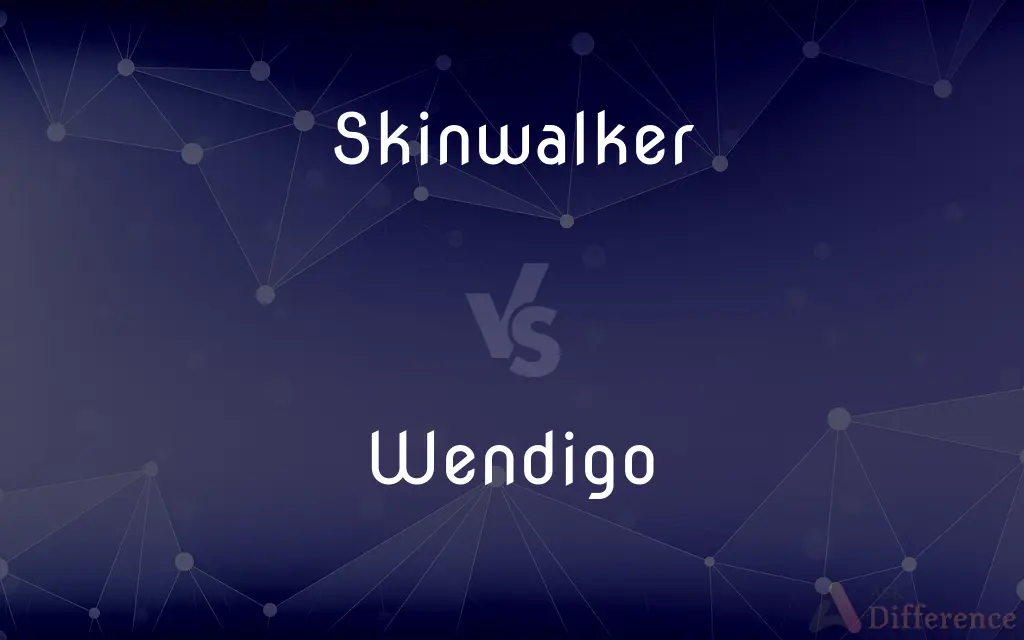Skinwalker vs. Wendigo — What's the Difference?
By Tayyaba Rehman — Updated on November 1, 2023
Skinwalkers are shapeshifting witches from Navajo lore; Wendigos are cannibalistic entities from Algonquian myth.

Difference Between Skinwalker and Wendigo
Table of Contents
ADVERTISEMENT
Key Differences
Skinwalkers, deriving from Navajo culture, are humans who practice witchcraft to shape-shift into animals. The term "skinwalker" is a literal translation of the Navajo "yee naaldlooshii," which means "with it, he goes on all fours." Skinwalkers are regarded as malevolent beings who willingly chose the path of evil. They are feared and rarely discussed among the Navajo, as it's believed that speaking of them can attract their attention.
Wendigos are supernatural beings rooted in the folklore of the Algonquian-speaking peoples of North America. Unlike skinwalkers, a Wendigo is not a human that chose a path but rather a spirit associated with winter, cold, famine, and starvation. The Wendigo is often depicted as a monstrous creature with an insatiable hunger for human flesh, and its mythology serves as a cautionary tale against greed and excess.
A fundamental difference between Skinwalkers and Wendigos lies in their origins. A skinwalker is a human witch capable of transforming into animals, often seen as an evil sorcerer using his powers for personal gain. In contrast, a Wendigo is a creature born from a human overwhelmed by greed or resorting to cannibalism; it's a monstrous entity, often reflecting environmental hardships and cultural taboos.
In representation, Skinwalkers are often depicted in various animal forms, maintaining some human characteristics, signifying their retained human consciousness and volition. Wendigos are characterized by their emaciated appearance, signifying their constant hunger and their connection to starvation and the insatiable.
The fear they inspire also differs; Skinwalkers evoke a fear of betrayal by one of the community turning against its members, while Wendigos symbolize the fear of losing oneself to base instincts and the terror that comes from the environment's harshness. While both are regarded as omens of bad tidings, the Skinwalker is often seen as a more personal threat, whereas the Wendigo embodies a more existential dread.
ADVERTISEMENT
Comparison Chart
Cultural Origin
Navajo tradition
Algonquian folklore
Nature
Human witches with the power to shapeshift
Supernatural entities born from human greed or cannibalism
Symbolism
Betrayal, malevolence, and the perversion of natural laws
Greed, gluttony, and the destructive power of nature
Physical Depiction
Animalistic features with human traits
Emaciated, often with deer-like characteristics
Taboo
Speaking of them is taboo for fear of retribution
Embodies cultural taboos against cannibalism and excess
Compare with Definitions
Skinwalker
A Skinwalker is a shapeshifting witch in Navajo legend.
The rancher suspected a Skinwalker when he saw the coyote standing on two legs.
Wendigo
A Wendigo is a cannibalistic monster from Algonquian myth.
The Wendigo was blamed when hunters found the abandoned camp with eerie signs of a feast.
Skinwalker
In Navajo culture, Skinwalkers are feared for their malevolent activities.
She whispered about a Skinwalker after livestock began vanishing.
Wendigo
Wendigos are associated with winter, hunger, and starvation.
As the famine worsened, whispers of a Wendigo grew among the tribe.
Skinwalker
The Skinwalker is believed to be an evil human capable of animating animal hides.
Local folklore says a Skinwalker lurks in the woods, hidden within the skin of a wolf.
Wendigo
Wendigos are depicted as gaunt, reflecting their insatiable hunger.
The figure in the snow, more skeleton than man, was the spitting image of a Wendigo.
Skinwalker
Skinwalkers are sorcerers who transform into animals by wearing their skins.
After hearing the skinwalker's howl, the campers felt an eerie presence.
Wendigo
The transformation into a Wendigo is often seen as a curse.
Lost in the blizzard, he feared the hunger would turn him into a Wendigo.
Skinwalker
Skinwalkers are considered dangerous and are avoided in discussion.
The Navajo warned them not to speak of Skinwalkers, lest they call one to them.
Wendigo
The Wendigo legend warns against greed and excess.
He was consumed by greed, and the elders said a Wendigo's spirit would claim him if he didn't change.
Skinwalker
A person, in certain Native American mythologies, who can transform into any animal when wearing its pelt.
Wendigo
Wendigo () is a mythological creature or evil spirit which originates from the folklore of First Nations based in and around the East Coast forests of Canada, the Great Plains region of the United States, and the Great Lakes region of the United States and Canada, grouped in modern ethnology as speakers of Algonquian-family languages. The wendigo is often said to be a malevolent spirit, sometimes depicted as a creature with human-like characteristics, which possesses human beings.
Wendigo
(mythological creature) A malevolent and violent cannibal spirit found in Anishinaabe, Ojibwe, and Cree mythology, which is said to inhabit the body of a living person and possess him or her to commit murder.
Wendigo
Synonym of splake
Common Curiosities
Do Skinwalkers have a specific animal they turn into?
Skinwalkers can transform into various animals, often predatory ones.
What is a Skinwalker?
A Skinwalker is a being from Navajo legend that can transform into animals.
Where does the Wendigo come from?
The Wendigo originates from Algonquian folklore in North America.
Are Skinwalkers and Wendigos considered evil?
Yes, both are often depicted as malevolent in their respective cultures.
Is the Wendigo associated with a particular season?
Yes, Wendigos are often linked to winter and cold.
Are Wendigos immortal?
Wendigos are often described as being nearly immortal and very difficult to destroy.
Can Skinwalkers and Wendigos be seen in daylight?
Both are typically nocturnal in myths, but there are no strict rules about their appearance.
Do Skinwalkers have a weakness?
Stories vary, but some suggest Skinwalkers can be harmed if their true identity is known.
Can Skinwalkers choose to stop being Skinwalkers?
Mythology suggests that being a Skinwalker is a deliberate choice tied to witchcraft.
Is it safe to speak about Skinwalkers and Wendigos?
In the cultures that believe in them, discussing these beings is often considered dangerous.
Do Wendigos have a human form?
Wendigos were once human but become monstrous, losing most human features.
How does one become a Skinwalker?
In legend, one becomes a Skinwalker through forbidden witchcraft rituals.
How does one become a Wendigo?
A person becomes a Wendigo through cannibalism or being consumed by greed, according to myth.
Can Wendigos communicate with humans?
Wendigos are sometimes said to mimic human voices to lure their victims.
Are there any defenses against Skinwalkers?
Folklore suggests that various protective charms and rituals can ward off Skinwalkers.
Share Your Discovery

Previous Comparison
Reliable vs. Trustworthy
Next Comparison
Molasses vs. SyrupAuthor Spotlight
Written by
Tayyaba RehmanTayyaba Rehman is a distinguished writer, currently serving as a primary contributor to askdifference.com. As a researcher in semantics and etymology, Tayyaba's passion for the complexity of languages and their distinctions has found a perfect home on the platform. Tayyaba delves into the intricacies of language, distinguishing between commonly confused words and phrases, thereby providing clarity for readers worldwide.















































